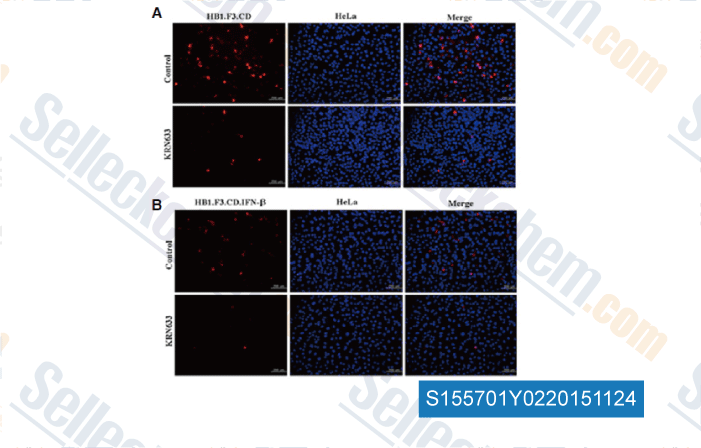|
Toll Free: (877) 796-6397 -- USA and Canada only -- |
Fax: +1-832-582-8590 Orders: +1-832-582-8158 |
Tech Support: +1-832-582-8158 Ext:3 Please provide your Order Number in the email. |
Technical Data
| Formula | C20H21ClN4O4 |
||||||
| Molecular Weight | 416.86 | CAS No. | 286370-15-8 | ||||
| Solubility (25°C)* | In vitro | DMSO | 9 mg/mL (21.58 mM) | ||||
| Water | Insoluble | ||||||
| Ethanol | Insoluble | ||||||
| In vivo (Add solvents to the product individually and in order) |
|
||||||
|
* <1 mg/ml means slightly soluble or insoluble. * Please note that Selleck tests the solubility of all compounds in-house, and the actual solubility may differ slightly from published values. This is normal and is due to slight batch-to-batch variations. * Room temperature shipping (Stability testing shows this product can be shipped without any cooling measures.) |
|||||||
Preparing Stock Solutions
Biological Activity
| Description | KRN 633 is an ATP-competitive inhibitor of VEGFR1/2/3 with IC50 of 170 nM/160 nM/125 nM, weakly inhibits PDGFR-α/β and c-Kit, does not block the phosphorylation of FGFR-1, EGFR or c-Met in cell. | |||||||||||
|---|---|---|---|---|---|---|---|---|---|---|---|---|
| Targets |
|
|||||||||||
| In vitro | KRN 633, a novel quinazoline urea derivative, strongly inhibits VEGFR1, VEGFR2 and VEGFR3 receptors with IC50 values of 170 nM, 160 nM and 125 nM respectively. It shows lower inhibitory activity towards non-RTKs, such as PDGF receptor (PDGFRα and β, c-Kit, breast tumor kinase, and tunica interna endothelial cell kinase tyrosine kinases (IC50 = 965, 9850, 4330, 9200, and 9900 nM, respectively). This compound potently inhibits ligand VEGF induced phosphorylation of VEGFR2 in HUVECs with an IC50 of 1.16 nM. It also inhibits VEGF-dependent, but not bFGF-dependent, phosphorylation of the MAP kinases in endothelial cells, with IC50 values of 3.51 nM and 6.08 nM for ERK1 and ERK2, respectively. This chemical has also been shown to inhibit the VEGF-driven proliferation of HUVECs with an IC50 of 14.9 nM, but it only suppresses FGF-driven proliferation at 3 μM weakly. [1] It inhibits hypoxia-induced transcriptional activation of HIF-1α in a concentration-dependent manner with an IC50 of 3.79 μM, through the inhibition of both Akt and ERK phosphorylation signaling pathways. [2] | |||||||||||
| In vivo | Although not cytotoxic to various cancer cells in vitro, KRN633 exhibits excellent antitumor activity in vivo due to its inhibitory effect on tumor vessel formation and vascular permeability. Once-daily administration of this compound at 100 mg/kg/d produces significant tumor growth inhibition in A549, LC-6-LCK, HT29, Ls174T, LNCap and Du145 cells while twice-daily administration of this compound at 100 mg/kg induces ~90% growth inhibition of HT29 tumors. [1] Treatment of mid-pregnancy mice with this chemical (300 mg/kg, p.o.) reduces the blood supply to fetal tissues due to diminished vascularization in both placenta and fetal organs and consequently increases the risk of induction of intrauterine growth restriction (IUGR). [3] |
Protocol (from reference)
| Kinase Assay:[1] |
|
|---|---|
| Cell Assay:[1] |
|
| Animal Study:[1] |
|
References
|
Customer Product Validation

-
Data from [ , , Mol Cells, 2013, 36:347-354. ]
Selleck's KRN 633 Has Been Cited by 6 Publications
| The in vitro effect of VEGF receptor inhibition on primary alveolar osteoblast nodule formation. [ Aust Dent J, 2020, 10.1111/adj.12752] | PubMed: 32072641 |
| Regorafenib induces adaptive resistance of colorectal cancer cells via inhibition of vascular endothelial growth factor receptor. [ J Med Invest, 2017, 64(3.4):262-265] | PubMed: 28954993 |
| Synergistic effect of therapeutic stem cells expressing cytosine deaminase and interferon-beta via apoptotic pathway in the metastatic mouse model of breast cancer. [ Oncotarget, 2016, 7(5):5985-99] | PubMed: 26716512 |
| Deconstructing the Iboga Alkaloid Skeleton: Potentiation of FGF2-induced Glial Cell Line-Derived Neurotrophic Factor Release by a Novel Compound [ ACS Chem Biol, 2016, 11(1):77-87] | PubMed: 26517751 |
| Co-treatment with therapeutic neural stem cells expressing carboxyl esterase and CPT-11 inhibit growth of primary and metastatic lung cancers in mice. [ Oncotarget, 2014, 5(24):12835-48] | PubMed: 25544747 |
| Anticancer effects of the engineered stem cells transduced with therapeutic genes via a selectivetumor tropism caused by vascular endothelial growth factor toward HeLa cervical cancer cells. [Kim HS, et al. Mol Cells, 2013, 36(4):347-54] | PubMed: 24008363 |
RETURN POLICY
Selleck Chemical’s Unconditional Return Policy ensures a smooth online shopping experience for our customers. If you are in any way unsatisfied with your purchase, you may return any item(s) within 7 days of receiving it. In the event of product quality issues, either protocol related or product related problems, you may return any item(s) within 365 days from the original purchase date. Please follow the instructions below when returning products.
SHIPPING AND STORAGE
Selleck products are transported at room temperature. If you receive the product at room temperature, please rest assured, the Selleck Quality Inspection Department has conducted experiments to verify that the normal temperature placement of one month will not affect the biological activity of powder products. After collecting, please store the product according to the requirements described in the datasheet. Most Selleck products are stable under the recommended conditions.
NOT FOR HUMAN, VETERINARY DIAGNOSTIC OR THERAPEUTIC USE.
